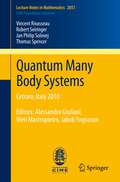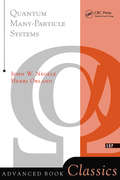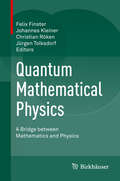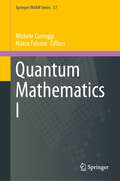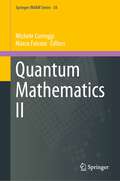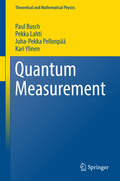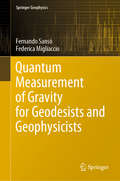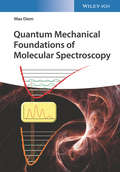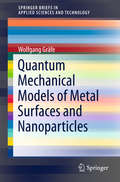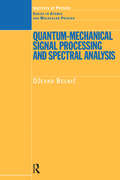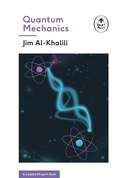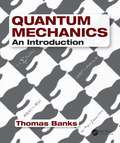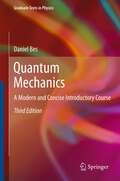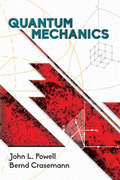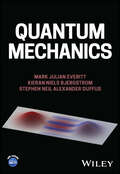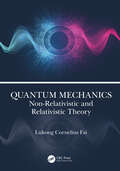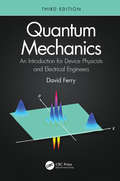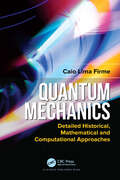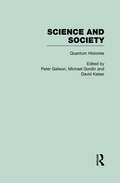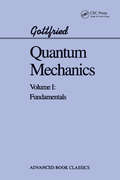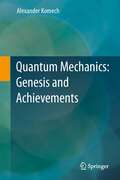- Table View
- List View
Quantum Many Body Systems
by Vieri Mastropietro Jakob Yngvason Vincent Rivasseau Jan Philip Solovej Thomas Spencer Alessandro Giuliani Robert SeiringerThe book is based on the lectures given at the CIME school "Quantum many body systems" held in the summer of 2010. It provides a tutorial introduction to recent advances in the mathematics of interacting systems, written by four leading experts in the field: V. Rivasseau illustrates the applications of constructive Quantum Field Theory to 2D interacting electrons and their relation to quantum gravity; R. Seiringer describes a proof of Bose-Einstein condensation in the Gross-Pitaevski limit and explains the effects of rotating traps and the emergence of lattices of quantized vortices; J.-P. Solovej gives an introduction to the theory of quantum Coulomb systems and to the functional analytic methods used to prove their thermodynamic stability; finally, T. Spencer explains the supersymmetric approach to Anderson localization and its relation to the theory of random matrices. All the lectures are characterized by their mathematical rigor combined with physical insights.
Quantum Many-particle Systems (Advanced Books Classics Ser.)
by John W. NegeleThis book explains the fundamental concepts and theoretical techniques used to understand the properties of quantum systems having large numbers of degrees of freedom. A number of complimentary approaches are developed, including perturbation theory; nonperturbative approximations based on functional integrals; general arguments based on order parameters, symmetry, and Fermi liquid theory; and stochastic methods.
Quantum Mathematical Physics
by Felix Finster Johannes Kleiner Christian Röken Jürgen TolksdorfQuantum physics has been highly successful for more than 90 years. Nevertheless, a rigorous construction of interacting quantum field theory is still missing. Moreover, it is still unclear how to combine quantum physics and general relativity in a unified physical theory. Attacking these challenging problems of contemporary physics requires highly advanced mathematical methods as well as radically new physical concepts. This book presents different physical ideas and mathematical approaches in this direction. It contains a carefully selected cross-section of lectures which took place in autumn 2014 at the sixth conference ``Quantum Mathematical Physics - A Bridge between Mathematics and Physics'' in Regensburg, Germany. In the tradition of the other proceedings covering this series of conferences, a special feature of this book is the exposition of a wide variety of approaches, with the intention to facilitate a comparison. The book is mainly addressed to mathematicians and physicists who are interested in fundamental questions of mathematical physics. It allows the reader to obtain a broad and up-to-date overview of a fascinating active research area.
Quantum Mathematics I (Springer INdAM Series #57)
by Michele Correggi Marco FalconiThis book is the first volume that provides an unique overview of the most recent and relevant contributions in the field of mathematical physics with a focus on the mathematical features of quantum mechanics. It is a collection of review papers together with brand new works related to the activities of the INdAM Intensive Period "INdAM Quantum Meetings (IQM22)", which took place at the Politecnico di Milano in Spring 2022 at Politecnico di Milano. The range of topics covered by the book is wide, going ranging from many-body quantum mechanics to semiclassical analysis, quantum field theory, Schrödinger and Dirac operators and open quantum systems
Quantum Mathematics II (Springer INdAM Series #58)
by Michele Correggi Marco FalconiThis book is the second volume that provides an unique overview of the most recent and relevant contributions in the field of mathematical physics with a focus on the mathematical features of quantum mechanics. It is a collection of review papers together with brand new works related to the activities of the INdAM Intensive Period "INdAM Quantum Meetings (IQM22)", which took place at the Politecnico di Milano in Spring 2022 at Politecnico di Milano. The range of topics covered by the book is wide, going ranging from many-body quantum mechanics to quantum field theory and open quantum systems.
Quantum Measurement
by Kari Ylinen Juha-Pekka Pellonpää Pekka Lahti Paul BuschThis is a book about the Hilbert space formulation of quantum mechanics and its measurement theory. It contains a synopsis of what became of the Mathematical Foundations of Quantum Mechanics since von Neumann's classic treatise with this title. Fundamental non-classical features of quantum mechanics--indeterminacy and incompatibility of observables, unavoidable measurement disturbance, entanglement, nonlocality--are explicated and analysed using the tools of operational quantum theory. The book is divided into four parts: 1. Mathematics provides a systematic exposition of the Hilbert space and operator theoretic tools and relevant measure and integration theory leading to the Naimark and Stinespring dilation theorems; 2. Elements develops the basic concepts of quantum mechanics and measurement theory with a focus on the notion of approximate joint measurability; 3. Realisations offers in-depth studies of the fundamental observables of quantum mechanics and some of their measurement implementations; and 4. Foundations discusses a selection of foundational topics (quantum-classical contrast, Bell nonlocality, measurement limitations, measurement problem, operational axioms) from a measurement theoretic perspective. The book is addressed to physicists, mathematicians and philosophers of physics with an interest in the mathematical and conceptual foundations of quantum physics, specifically from the perspective of measurement theory.
Quantum Measurement and Control
by Howard M. Wiseman Gerard J. MilburnThe control of individual quantum systems promises a new technology for the 21st century - quantum technology. This book is the first comprehensive treatment of modern quantum measurement and measurement-based quantum control, which are vital elements for realizing quantum technology. Readers are introduced to key experiments and technologies through dozens of recent experiments in cavity QED, quantum optics, mesoscopic electronics, and trapped particles several of which are analyzed in detail. Nearly 300 exercises help build understanding, and prepare readers for research in these exciting areas. This important book will interest graduate students and researchers in quantum information, quantum metrology, quantum control and related fields. Novel topics covered include adaptive measurement; realistic detector models; mesoscopic current detection; Markovian, state-based and optimal feedback; and applications to quantum information processing.
Quantum Measurement of Gravity for Geodesists and Geophysicists (Springer Geophysics)
by Fernando Sansò Federica MigliaccioDuring the last thirty years a great advancement in low energy physics, particularly interactions of atoms with the electromagnetic field, has been achieved and the development of electronics and laser techniques has allowed to implement a fine manipulation of atoms with photons. A wealth of important applications has sprung out from the ability of manipulating large samples of cold atoms. Among them, the improvement of atomic clocks and the creation of atomic gyroscopes and of atomic gravity meters, which is obviously of great interest for geodesists and geophysicists, particularly for potential applications in satellite geodesy.This book explains the fundamental concepts necessary to understand atom manipulation by photons, including the principles of quantum mechanics. It is conceived as a road that leads the reader from classical physics (mechanics and electromagnetism, considered as a common scientific background of geodesists and geophysicists), to the basics of quantum mechanics in order to understand the dynamics of atoms falling in the gravity field, while interacting with suitably resonant laser beams. There are different types of measurements of gravity based on the manipulation of ultra-cold atoms; the book presents the principles of the instruments based on stimulated Raman transition, which can be easily worked out analytically. However, the concepts explained in the text can provide a good starting point to understand also the applications based on the so-called Block oscillations or on the Bose–Einstein condensation.
Quantum Measurement Theory and its Applications
by Kurt JacobsRecent experimental advances in the control of quantum superconducting circuits, nano-mechanical resonators and photonic crystals has meant that quantum measurement theory is now an indispensable part of the modelling and design of experimental technologies. This book, aimed at graduate students and researchers in physics, gives a thorough introduction to the basic theory of quantum measurement and many of its important modern applications. Measurement and control is explicitly treated in superconducting circuits and optical and opto-mechanical systems, and methods for deriving the Hamiltonians of superconducting circuits are introduced in detail. Further applications covered include feedback control, metrology, open systems and thermal environments, Maxwell's demon, and the quantum-to-classical transition.
Quantum Mechanical Foundations of Molecular Spectroscopy
by Max DiemA concise textbook bridging quantum theory and spectroscopy! Designed as a practical text, Quantum Mechanical Foundations of Molecular Spectroscopy covers the quantum mechanical fundamentals of molecular spectroscopy from the view of a professional spectroscopist, rather than a theoretician. Written by a noted expert on the topic, the book puts the emphasis on the relationship between spectroscopy and quantum mechanics, and provides the background information and derivations of the subjects needed to understand spectroscopy including: stationary energy states, transitions between these states, selection rules, and symmetry. The phenomenal growth of all forms of spectroscopy over the past eight decades has contributed enormously to our understanding of molecular structure and properties. Today spectroscopy covers a broad field including the modern magnetic resonance techniques, non-linear, laser and fiber-based spectroscopy, surface and surface-enhanced spectroscopy, pico- and femtosecond time resolved spectroscopy, and many more. This up-to-date resource discusses several forms of spectroscopy that are used in many fields of science, such as fluorescence, surface spectroscopies, linear and non-linear Raman spectroscopy and spin spectroscopy. This important text: Contains the physics and mathematics needed to understand spectroscopy Explores spectroscopic methods the are widely used in chemistry, biophysics, biology, and materials science Offers a text written by an experienced lecturer and practitioner of spectroscopic methods Includes detailed explanations and worked examples Written for chemistry, biochemistry, material sciences, and physics students, Quantum Mechanical Foundations of Molecular Spectroscopy provides an accessible text for understanding molecular spectroscopy.
Quantum Mechanical Models of Metal Surfaces and Nanoparticles
by Wolfgang GräfeThis book proposes two simple quantum mechanical models for the analytical description of metal surfaces and nanoparticles. It gives an ostensive picture of the forces acting in a metal surface and deduces analytical formulae for the description of their physical properties. This book explains the relation between near-surface stress and familiar surface parameters. The concept of the separation of the three-dimensional body into three one-dimensional subsystems was applied. The content is of interest to all those working in the field of surface physics.
Quantum-Mechanical Signal Processing and Spectral Analysis (Series in Atomic Molecular Physics)
by Dzevad BelkicQuantum-Mechanical Signal Processing and Spectral Analysis describes the novel application of quantum mechanical methods to signal processing across a range of interdisciplinary research fields. Conventionally, signal processing is viewed as an engineering discipline with its own specific scope, methods, concerns and priorities, not usually encompassing quantum mechanics. However, the dynamics of systems that generate time signals can be successfully described by the general principles and methods of quantum physics, especially within the Schroedinger framework. Most time signals that are measured experimentally are mathematically equivalent to quantum-mechanical auto-correlation functions built from the evolution operator and wavefunctions. This fact allows us to apply the rich conceptual strategies and mathematical apparatus of quantum mechanics to signal processing. Among the leading quantum-mechanical signal processing methods, this book emphasizes the role of Pade approximant and the Lanczos algorithm, highlighting the major benefits of their combination. These two methods are carefully incorporated within a unified framework of scattering and spectroscopy, developing an algorithmic power that can be exported to other disciplines. The novelty of the author's approach to key signal processing problems, the harmonic inversion and the moment problem, is in establishing the Pade approximant and Lanczos algorithm as entirely algerbraic spectral estimators. This is of paramount theoretical and practical importance, as now spectral analysis can be carried out from closed analytical expressions. This overrides the notorious mathematical ill-conditioning problems with round-off errors that plague inverse reconstructions in those fields that rely upon signal processing. Quantum-Mechanical Signal Processing and Spectral Analysis will be an invaluable resource for researchers involved in signal processing across a wide range of disciplines.
Quantum Mechanics (The Ladybird Expert Series #2)
by Jim Al-KhaliliWhat is quantum mechanics? Learn from the experts in the ALL-NEW LADYBIRD EXPERT SERIESA clear, simple and entertaining introduction to the weird, mind-bending world of the very, very small.Written by physicist and broadcaster Professor Jim Al-Khalili, Quantum Mechanics explores all the key players, breakthroughs, controversies and unanswered questions of the quantum world.You'll discover:- How the sun shines- Why light is both a wave and a particle- The certainty of the Uncertainty Principle- Schrodinger's Cat- Einstein's spooky action- How to build a quantum computer- Why quantum mechanics drives even its experts completely crazy'Jim Al-Khalili has done an admirable job of condensing the ideas of quantum physics from Max Planck to the possibilities of quantum computers into brisk, straightforward English' THE TIMESLearn about other topics in the Ladybird Experts series including The Big Bang, Gravity, Climate Change and Evolution.Written by the leading lights and most outstanding communicators in their fields, the Ladybird Expert books provide clear, accessible and authoritative introductions to subjects drawn from science, history and culture. For an adult readership, the Ladybird Expert series is produced in the same iconic small format pioneered by the original Ladybirds. Each beautifully illustrated book features the first new illustrations produced in the original Ladybird style for nearly forty years.
Quantum Mechanics
by Gennaro Auletta Mauro Fortunato Giorgio ParisiThe important changes quantum mechanics has undergone in recent years are reflected in this new approach for students. A strong narrative, and over 300 worked problems lead the student from experiment, through general principles of the theory, to modern applications. Stepping through results allows students to gain a thorough understanding. Starting with basic quantum mechanics, the book moves on to more advanced theory, followed by applications, perturbation methods and special fields, and ending with new developments in the field. Historical, mathematical, and philosophical boxes guide the student through the theory. Unique to this textbook are chapters on measurement and quantum optics, both at the forefront of current research. Advanced undergraduate and graduate students will benefit from this new perspective on the fundamental physical paradigm and its applications. Online resources including solutions to selected problems, and 200 figures, with color versions of some figures, are available online.
Quantum Mechanics: An Introduction
by Thomas Banks"pedagogical and accessible"—Nathan Seiberg, Professor, Institute for Advanced Study, Princeton, New Jersey "an excellent book"—Andreas Karch, Professor, University of Washington "provides remarkable insights into technical aspects of the subject, but also into the most basic conceptual questions which trouble both new students and more mature researchers"—Michael Dine, Professor, University of California, Santa Cruz This authoritative, advanced introduction provides a complete, modern perspective on quantum mechanics. It clarifies many common misconceptions regarding wave/particle duality and the correct interpretation of measurements. The author develops the text from the ground up, starting from the fundamentals and presenting information at an elementary level, avoiding unnecessarily detailed and complex derivations in favor of simple, clear explanations. He begins in the simplest context of a two-state system and shows why quantum mechanics is inevitable, and what its relationship is to classical mechanics. He also outlines the decoherence approach to interpreting quantum mechanics. Distinguishing features: Provides a thorough grounding in the principles and practice of quantum mechanics, including a core understanding of the behavior of atoms, molecules, solids, and light. Utilizes easy-to-follow examples and analogies to illustrate important concepts. Helps develop an intuitive sense for the field, by guiding the reader to understand how the correct formulas reduce to the non-relativistic ones. Includes numerous worked examples and problems for each chapter. Thomas Banks is a theoretical physicist at University of California, Santa Cruz and a professor at Rutgers University. He earned his PhD in physics from the Massachusetts Institute of Technology, and has been a visiting scholar at the Institute for Advanced Study in Princeton, New Jersey. Professor Banks is the recipient of a Guggenheim Fellowship and is an elected member of the American Academy of Arts and Sciences.
Quantum Mechanics
by Daniel BesStarting from basic principles, the book covers a wide variety of topics, ranging from Heisenberg, Schroedinger, second quantization, density matrix and path integral formulations of quantum mechanics, to applications that are (or will be) corner stones of present and future technologies. The emphasis is on spin waves, quantum information, recent tests of quantum physics and decoherence. The book provides a large amount of information without unbalancing the flow of the main ideas by laborious detail.
Quantum Mechanics
by Eugene D. ComminsEugene D. Commins takes an experimentalist's approach to quantum mechanics, preferring to use concrete physical explanations over formal, abstract descriptions to address the needs and interests of a diverse group of students. Keeping physics at the foreground and explaining difficult concepts in straightforward language, Commins examines the many modern developments in quantum physics, including Bell's inequalities, locality, photon polarization correlations, the stability of matter, Casimir forces, geometric phases, Aharonov-Bohm and Aharonov-Casher effects, magnetic monopoles, neutrino oscillations, neutron interferometry, the Higgs mechanism, and the electroweak standard model. The text is self-contained, covering the necessary background on atomic and molecular structure in addition to the traditional topics. Developed from the author's well-regarded course notes for his popular first-year graduate course at UC Berkeley, instruction is supported by over 160 challenging problems to illustrate concepts and provide students with ample opportunity to test their knowledge and understanding.
Quantum Mechanics (Dover Books on Physics)
by Bernd Crasemann John L. PowellSuitable for advanced undergraduates, this thorough text focuses on the role of symmetry operations and the essentially algebraic structure of quantum-mechanical theory. Based on courses in quantum mechanics taught by the authors, the treatment provides numerous problems that require applications of theory and serve to supplement the textual material.Starting with a historical introduction to the origins of quantum theory, the book advances to discussions of the foundations of wave mechanics, wave packets and the uncertainty principle, and an examination of the Schrödinger equation that includes a selection of one-dimensional problems. Subsequent topics include operators and eigenfunctions, scattering theory, matrix mechanics, angular momentum and spin, and perturbation theory. The text concludes with a brief treatment of identical particles and a helpful Appendix.
Quantum Mechanics
by Mark Julian Everitt Kieran Niels Bjergstrom Stephen Neil DuffusQUANTUM MECHANICS From classical analytical mechanics to quantum mechanics, simulation, foundations & engineering Quantum mechanics is a fundamental and conceptually challenging area of physics. It is usually assumed that students are unfamiliar with Lagrangian and Hamiltonian formulations of classical mechanics and the role played by probability. As a result, quantum physics is typically introduced using heuristic arguments, obscuring synergies with classical mechanics. This book takes an alternative approach by leveraging classical analytical mechanics to facilitate a natural transition to quantum physics. By doing so, a solid foundation for understanding quantum phenomena is provided. Key features of this textbook include: Mathematics and Classical Analytical Mechanics: The necessary mathematical background and classical analytical mechanics are introduced gradually, allowing readers to focus on one conceptual challenge at a time. Deductive Approach: Quantum mechanics is presented on the firm foundation of classical analytical mechanics, ensuring a logical progression of concepts. Pedagogical Features: This book includes helpful notes, worked examples, problems, computational challenges, and problem-solving approaches to enhance understanding. Comprehensive Coverage: Including advanced topics such as open quantum systems, phase-space methods, and computational methods for quantum physics including good programming practice and code design. Much of the code needed to reproduce figures throughout this book is included. Consideration of Foundations: The measurement problem and correspondence principle are addressed, including an open and critical discussion of their interpretation and consequences. Introduction to Quantum Systems Engineering: This is the first book to introduce Quantum Systems Engineering approaches for applied quantum technologies development. This textbook is suitable for undergraduate students in physics and graduate students in mathematics, chemistry, engineering, and materials science.
Quantum Mechanics: Non-Relativistic and Relativistic Theory
by Lukong Cornelius FaiThis book presents an accessible treatment of non-relativistic and relativistic quantum mechanics. It is an ideal textbook for undergraduate and graduate physics students, and is also useful to researchers in theoretical physics, quantum mechanics, condensed matter, mathematical physics, quantum chemistry, and electronics. This student-friendly and self-contained textbook covers the typical topics in a core undergraduate program, as well as more advanced, graduate-level topics with an elegant mathematical rigor, contemporary style, and rejuvenated approach. It balances theory and worked examples, which reinforces readers' understanding of fundamental concepts. The analytical methods employed in this book describe physical situations with mathematical rigor and in-depth clarity, emphasizing the essential understanding of the subject matter without need for prior knowledge of classical mechanics, electromagnetic theory, atomic structure, or differential equations. Key Features: • Remains accessible but incorporates a rigorous, updated mathematical treatment• Laid out in a student-friendly structure• Balances theory with its application through examples Lukong Cornelius Fai is a professor of theoretical physics at the Department of Physics, Faculty of Sciences, University of Dschang, Cameroon. He is Head of Condensed Matter and Nanomaterials as well as the Mesoscopic and Multilayer Structures Laboratory. He was formerly a senior associate at the Abdus Salam International Centre for Theoretical Physics (ICTP), Italy. He holds a Master of Science in Physics and Mathematics (1991) as well as a Doctor of Science in Physics and Mathematics (1997) from Moldova State University. He is the author of over 170 scientific publications and five textbooks.
Quantum Mechanics: An Introduction for Device Physicists and Electrical Engineers
by David FerryQuantum Mechanics: An Introduction for Device Physicists and Electrical Engineers, Third Edition provides a complete course in quantum mechanics for students of semiconductor device physics and electrical engineering. It provides the necessary background to quantum theory for those starting work on micro- and nanoelectronic structures and is particularly useful for those beginning work with modern semiconductors devices, lasers, and qubits. This book was developed from a course the author has taught for many years with a style and order of presentation of material specifically designed for this audience. It introduces the main concepts of quantum mechanics which are important in everyday solid-state physics and electronics. Each topic includes examples which have been carefully chosen to draw upon relevant experimental research. It also includes problems with solutions to test understanding of theory. Full updated throughout, the third edition contains the latest developments, experiments, and device concepts, in addition to three fully revised chapters on operators and expectations and spin angular momentum, it contains completely new material on superconducting devices and approaches to quantum computing.
Quantum Mechanics: Detailed Historical, Mathematical and Computational Approaches
by Caio Lima FirmeMain features:i) A different approach for teaching Quantum Mechanics encompassing old quantum mechanics, matrix mechanics and wave mechanics in a historical perspective which helps to consolidate most important concepts of Quantum Mechanics;ii) Original information from the most important papers of Quantum Mechanics;iii) Derivation of all important equations of Quantum Mechanics, for example, Heisenberg’s uncertainty principle, de Broglie’s wave-particle duality, Schrödinger’s wave equation, etc., showing their interrelations through Dirac’s equations and other applications of matrix and wave mechanics;iv) Comprehensive mathematical support for the understanding of Quantum Mechanics; derivation of all equations make reading easier;v) The illustrations of the book cover examples, exercises and do-it-yourself activities;vi) Fundamentals of Fortran and numerical calculation along with the source codes for numerical solutions of several mathematical and quantum problems. All source codes are in the author’s site: (https://www.fortrancodes.com/);vii) Chapters devoted to linear algebra and differential equations applied to quantum mechanics and their numerical solutions;viii) Complete solution for the one-electron and two-electron problems using Schrödinger’s time independent equation along with their source codes.
Quantum Mechanics: Science and Society
by Peter Galison Michael Gordin David KaiserModern science has changed every aspect of life in ways that cannot be compared to developments of previous eras. This four-volume set presents key developments within modern physical science and the effects of these discoveries on modern global life. The first two volumes explore the history of the concept of relativity, the cultural roots of science, the concept of time and gravity before, during, and after Einstein's theory, and the cultural reception of relativity. Volume 3 explores the impact of modern science upon global politics and the creation of a new kind of war, and Volume 4 details the old and new efforts surrounding the elucidation of the quantum world, as well as the cultural impact of particle physics. This reprint collection pools the best scholarship available, collected from a large array of difficult to acquire books, journals, and pamphlets. Each volume begins with an introductory essay, written by one of the top scholars in the history of science. Students and scholars of modern culture, science, and society will find these volumes a veritable research gold mine.
Quantum Mechanics: Volume 1: Fundamentals (Graduate Texts In Contemporary Physics Series)
by Kurt GottfriedThis book contains discussions of radiation theory, quantum statistics and the many-body problem, and more advanced topics in collision theory. It is intended as a text for a first-year graduate quantum mechanics course.
Quantum Mechanics: Genesis and Achievements
by Alexander KomechThe focus of the present work is nonrelativistic and relativistic quantum mechanics with standard applications to the hydrogen atom. The author has aimed at presenting quantum mechanics in a comprehensive yet accessible for mathematicians and other non-physicists. The genesis of quantum mechanics, its applications to basic quantum phenomena, and detailed explanations of the corresponding mathematical methods are presented. The exposition is formalized (whenever possible) on the basis of the coupled Schroedinger, Dirac and Maxwell equations. Aimed at upper graduate and graduate students in mathematical and physical science studies.
